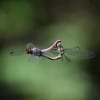
By Jim Stevenson
Please enjoy some other animals aside from our usual birds.
Many were in my yard this fall, or not far away.
Enjoy!
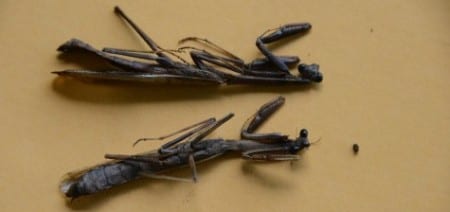
Praying Mantis are of many species, taking out other insects with lightning-fast strikes of their front appendages. I suspect the larger one (top) is the female, as is often the case with insects. These worked my windows for a coupla nights before expiring on the ground one morning. Mantids do fly and you can see their wingtips at the end of the abdomen. Walking sticks also appear on windows but after the superficial resemblance to mantids, they are easily told apart. They do not prey on insects the way mantids do, but they do squirt a nasty liquid in the eyes of intruders – including humans.
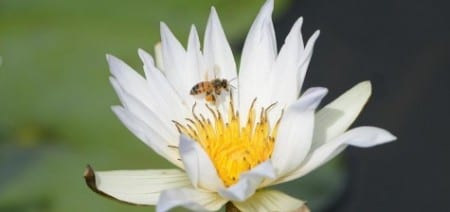
Back to the relationship between bees and flowers! This honey bee has been pollinating a water lily and appears to have quite a haul on its hind legs. This species has an amazing hive biology with several scientists spending their entire careers studying them. Social insects like these, some ants and termites have amazing life histories, with members of the collective all working in harmony for the survival of the hive. As Spock said, “The good of the many outweighs the good of the few, or the one.”
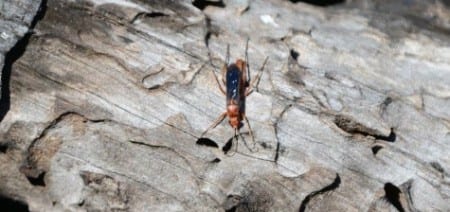
The order Hymenoptera includes all the bees, wasps and hornets, plus a few smaller groups. Some sting and aren’t fan favorites with many folks. Various birds catch them in their bills and beat them on limbs before swallowing. I’m not sure what this species is but I don’t think it’s a wasp that stings. Some insects mimic stinging varieties just as Scarlet Kingsnakes mimic Coral Snakes.
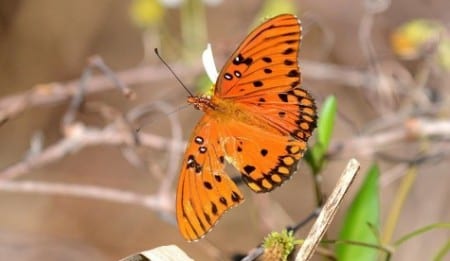
Butterflies really put on a show in fall, with many migrating south for the winter. Most probably don’t return. This is the Gulf Fritillary, a common species along the Gulf Coast with the Monarchs. This one has a booboo in its left wing but is bravely accomplishing the task of migration. The wings are actually very delicate but many predators take shots at them. Don’t ask me what “fritillary” means!
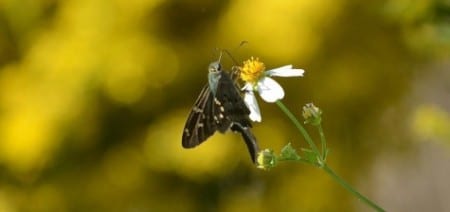
This is one of the skippers, a common group that flies over the Gulf of Mexico in fall, and has a long “tail” (abdomen) and unique-shaped wings. You can see from the picture that it’s taking food from the flower with long, curved tubes, and no doubt taking genetic material to other flowers. This is the deal they have with flowers, and millions of years ago it spawned the explosion of flowering plants and insects.
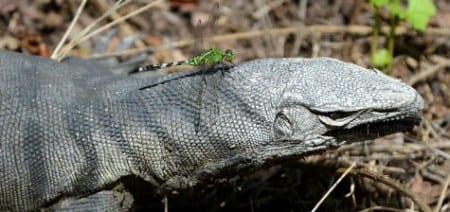
Mr. Rubber Iguana strikes again. I thought this was a Green Darner but my field guide is on my desk, 700 miles away. I think I got corrected, so don’t write that down! Dragonflies are one of the insects that lay their eggs in the water and in spring they emerge. These little bi-planes aren’t as fast as they are at changing height, and smaller insects coming up off the water are dead meat.
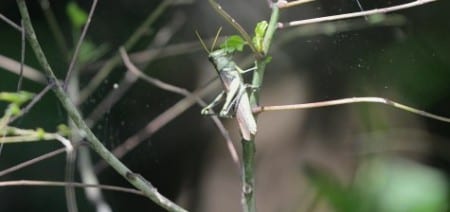
Grasshoppers become abundant in fall and do a lot of damage to green leaves. Of course, this was not lost on predators like shrikes, and nature works together to keep populations in balance. It is interesting to note that there is an enormous die-off in fall of millions of animals, but nature does much of its greatest refining in fall and winter. It is also a painful irony that almost every loved one I’ve ever lost, died in the fall. Go figure. 🙁
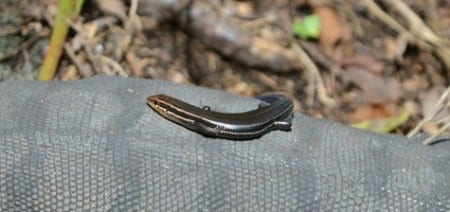
I have a mounted, rubber iguana which stays outside (he doesn’t eat much) and one of my skinks loves to lay on him and absorb heat. It’s interesting how lizards, turtles and even crocodilians will fold back their legs when sunning. Reptiles are our only true heliotherms, relying on the direct rays of the sun to warm up and become active. That’s why they are seen far less in winter.
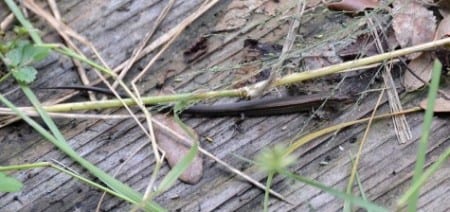
Ground Skinks are probably more abundant than other lizards in the East but they are hard to see, scurrying around through the grass. Some think they are salamanders, as they are shiny brown (those who don’t really know what a salamander looks like), but salamanders have no scales or claws. Both are hard to see unless you catch it and look carefully.
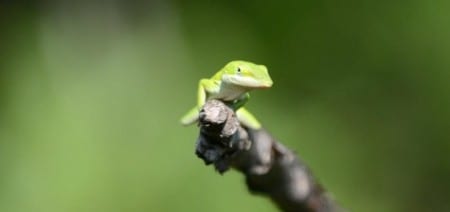
Most people know the Green Anole better than any other lizard. They do turn brown depending on certain variables but become quite common in many peoples’ yards in the Eastern United States. Anoles are climbers and are sometimes taken by Mississippi Kites in late spring (along with Broad-headed Skinks) out of the top of oaks, etc.
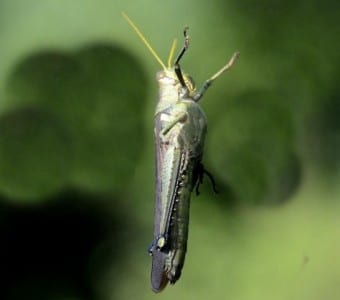
This large grasshopper rather expertly flew up and lit on my window pane as easily as I sit in my office chair. Insects have only three pairs of legs, and are attached to the thorax (their middle one of three sections). You can also see their antennae and the compound eye, giving insects awfully good vision. Of course, you couldn’t tell that by currently looking at my windshield.
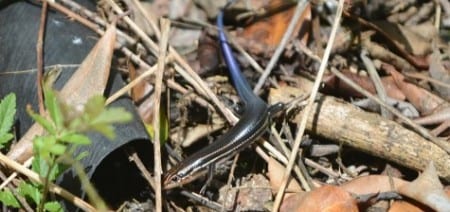
There are three very similar skinks in the South, and this is the Five-lined Skink. They have colonized my Island and I see them in many of the Galveston forests in recent years. Young like the one above have a blue tail, females are brown striped without the blue tail and adult males are mostly brown with an odd reddish head. If you look hard you can see the external ear openings halfway between the eye and the front leg. Skinks are shiny lizards and some may have a neurotoxic poison in their tail for predators that break off the tail and bite into it. Only the Gila Monster of the Desert Southwest has a venomous bite.
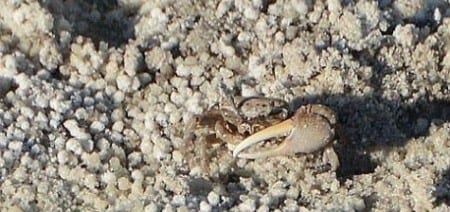
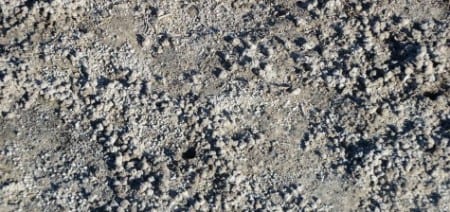
Have you ever seen sand balls like this along the seashore? These are the places where fiddler crabs eat! They sift through the sand for bacteria and then drop the scooped up and sifted sand on the ground as a ball. The males, with one large claw, leave the large balls of sand, and the females, with (two) tiny claws leave the smaller ones.
One marine biologist tried to figure out how various species of fiddler crabs remained species specific, as males wave their large claw for their prospective mate to go down the burrow with him. Well, he was unable to figger it out, but his wife, a music major, quickly realized that each species waved their claw in the air with a different rhythm.
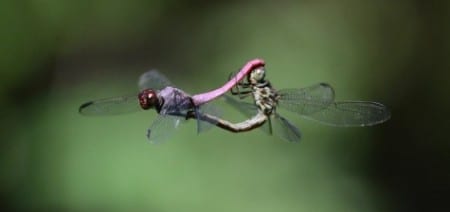
Not totally unlike the mating of the aforeshown bees are these dragonflies that have colonized my pond for their insect hunting. I am no entomologist, but I expect dragonflies kill about as many mosquitoes as any insectivore, and far more than some famous ones like bats (which eat largely beetles and moths). I used to catch these as a child and I called the smaller ones like these “fighters” and the larger ones the “bombers.” In retrospect, I think those were largely darners, but I’m not sure.
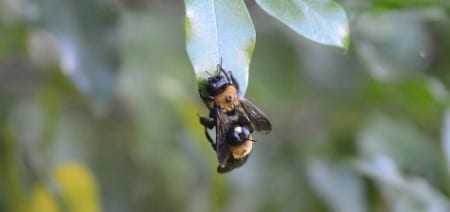
These two bumblebees are ensuring their future generation, mating like so many arthropods do in fall. The winter season is very stressful for many groups of animals, with low light and colder temperatures. These pollinators have an amazing relationship with flowering plants, perhaps the greatest mutualistic relationship in Earth’s history. There are other bees that look a good bit like bumblebees, like carpenter bees, etc.

 Posted in
Posted in 























